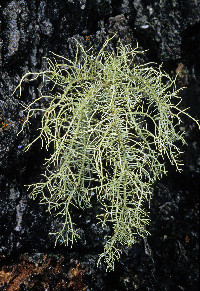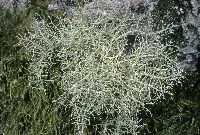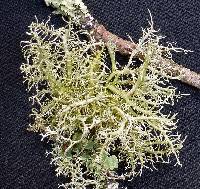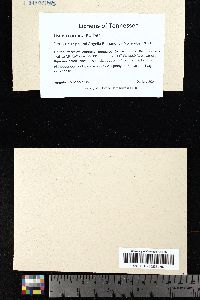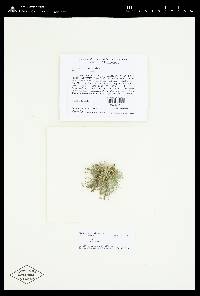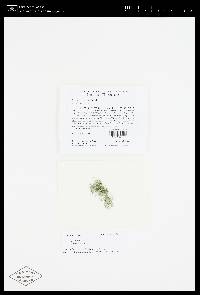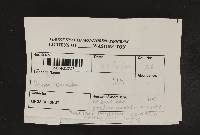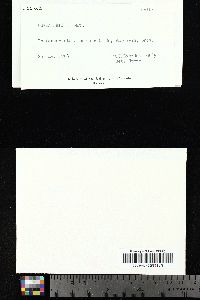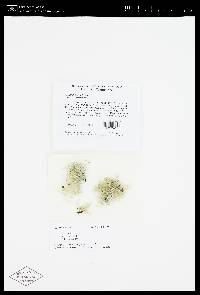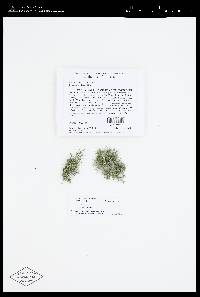
- Home
- Search
- Images
- Species Checklists
- US States: O-Z >
- US National Parks
- Central America
- South America
- US National Parks
- Southern Subpolar Region
|
|
|
|
Family: Parmeliaceae
[Usnea ceratina f. inflata Duby, moreUsnea confusa Asah., Usnea constrictula Stirt., Usnea inflata (Duby) Motyka, Usnea inflata var. cornuta (Körb.) Clauzade & Cl. Roux, Usnea inflata var. inflata Delise, Usnea intexta Stirt., Usnea intexta var. constrictula (Stirt.) D. Hawksw. & D. Chapm., Usnea intexta var. intexta Stirt., Usnea jelskii Motyka, Usnea subhirta (Vain.) Motyka, Usnea subpectinata Stirt.] |
MycoBank no. 408356 Usnea cornuta Körb. Detailed descriptions, particularly in comparison with U. brasiliensis can be found in Clerc (1987), Herrera-Campos et al. (2001), Clerc (2006, 2007, 2011a), and Herrera-Campos (2016). Chemistry. Medulla of the main chemotype with salazinic acid [P+ yellow, K+ yellow turning deep red, C–, KC–], other chemotypes additionally with ±norstictic, ±stictic, ±consalazinic, and/or ±fatty acids [spot test variable, e.g.: P+ yellow, K+ yellow turning orange (crystals), C–, KC], rarely no secondary metabolites found in the medulla [P–, K–, C–, KC–]. Ecology and distribution. New to Galapagos; previously reported from Europe, Macaronesia, North and South America, Japan, and Australia (Clerc 1987, 2006, Clerc 2007, 2011a, Herrera-Campos et al. 2001, Ohmura 2001). Herrera-Campos et al. (2001) observed that in Mexico U. cornuta and U. brasiliensis do not grow in the same habitat. In Galapagos U. brasiliensis appears to have a much more restricted distribution, so far it is only known from the humid zone of Isabela, whereas U. cornuta is widely distributed and equally common throughout both the transition and the humid zone; one specimen has also been found in the high altitude dry zone. No obvious differences can be distinguished regarding their substrate preferences; both grow most commonly as epiphytes, occasionally also on wood, rarely on rock. Nash, T.H., Ryan, B.D., Gries, C., Bungartz, F., (eds.) 2007. Lichen Flora of the Greater Sonoran Desert Region. Vol 3. Thallus: erect-shrubby, tufted, 2-5 cm long branching: the whole thallus anisotomic-dichotomous basal part: paler than or concolorous to branches or ±pale brown branches: tapering; lateral branches: distinctly narrowed at attachment point segments: terete, ±cylindrical to strongly sausage-like papillae/tubercles: verrucous, few to numerous, irregularly distributed mainly on secondary branches fibercles: absent fibrils: short (< 3mm) and thick, spinulous, unevenly distributed on the whole thallus, often numerous on the apices, giving a spinulous aspect to the terminal part of the thallus soralia: typically minute, smaller than half the diameter of the branch, often fusing together thus looking like a single large soralium, typically even to sometimes ±stipitate, not efflorescent-excrescent, primarily developing initially on the cortex (secondary branches and apices), rarely on top of tubercles (main and secondary branches), rarely present on main branches but mainly on terminal branches, plane, of irregular shape, usually without a sharply delimited cortical rim isidiomorphs: short (0.1-0.2 mm), numerous at the beginning but often absent on mature soralia pseudocyphellae: absent cortex: thin to moderately thick (4-7%), shiny medulla: moderately thick to thick, lax to dense central axis: thin to moderately thick, sometimes orange pigmented Apothecia: not seen Spot tests: either K+ yellow turning red, C-, KC-, P + orangish yellow, or K+ dull yellow turning reddish orange, C-, KC-, P+ deep yellow, or K+ yellow slowly turning orangish, C-, KC-, P+ deep orange, or K-, C-, KC-, P+ orangish yellow or K-, C-, KC-, P- Secondary metabolites: salazinic acid (major), ±consalazinic acid (minor), ±protocetraric acid (minor), ± norstictic acid (minor), ±fatty acids (minor); norstictic acid (major), ±fatty acids (minor); norstictic acid (major), lobaric acid (major); stictic acid (major), norstictic acid (major), ±constictic acid (minor), ±cryptostictic acid (minor), ±menegazziaic acid (minor); protocetraric acid (major); or none detected. |
|
|
|





